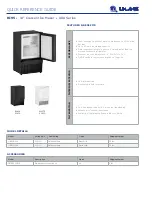
7. To add ingredients after the freezing process has begun,
gently add them through the Mixing Feeder.
8. To avoid overheating the Motor, the direction of the rotation
will change if the mixture becomes too thick. If the direction
of rotation continues to change, the mixture is completely
prepared, turn off unit immediately.
9. Remove Paddle from ice cream. Only use rubber, plastic,
or wooden utensils to serve from the Canister bowl. Metal
spoons may damage the bowl.
10. To further harden the ice cream, you may put the Canister
with the ice cream contents into the freezer for a short
period of time (no more than 30 minutes). Long term
freezing, however, should be done in an airtight container.
AUTO SAFETY SHUT OFF:
This Ice Cream Maker is supplied with an auto safety shutoff.
Should the motor become overheated it will turn off. In order
to restart the Ice Cream Maker the following steps must be
followed:
1. Unplug the Ice Cream Maker.
2. Wait at least 20 minutes for the motor to cool.
3. Plug in and operate normally.
h
ow
T
o
c
lean
Y
our
I
ce
c
ream
m
aker
Make sure the unit is turned off and unplugged. The gel canister
should be cleaned in warm water and mild detergent, then
dried thoroughly. Never clean with scouring powders or hard
implements.
Never replace Canister in Freezer if it is still wet. Do not use
sharp utensils, scouring pads or abrasive detergents when
cleaning Gel Canister.
The Motor Cover can be cleaned by using a damp cloth. Never
immerse Motor Cover in water.
Do not place canister in dishwasher!
6
7
h
elpful
h
InTs
• Some recipes require the mixture to be pre-cooked. Make
the recipe at least one day ahead. This will allow the mixture
to cool completely and adds volume.
• Uncooked recipes will yield best results when an electric
mixer is used to cream the eggs and sugar. This helps
increase volume in the ice cream mixture. Eggs must be
cooked properly. See our eggbased recipes for instructions.
• Most ice cream recipes are a combination of cream, milk,
eggs and sugar. You can use any type of cream you like, but
the type of cream you use will affect the flavor and texture.
The higher percentage of fat, the richer the ice cream and the
softer the texture. For example, heavy cream has at least 36%
fat, followed by: whipping cream (30%), coffee or light cream
(18%) and half & half (10%). Any combination can be used,
but make sure the liquid measurement remains the same. For
example, lighter ice creams can be made by using more milk
than cream, or by eliminating cream altogether. Skim milk may
be used, but there will be a noticeable difference in texture and
taste.
• The ice cream mixture will stay fresh in the refrigerator for
several days. Be sure to shake well before adding to the Canister.
• When pouring mixture into the Canister, be sure to stop at
least 1” (2.5 cm) from the top, as mixture will increase in
volume during the freezing process.
• Alcohol inhibits the freezing process. To add alcohol to a
recipe, add when the mixture is semi-stiff.
• The flavor of a sorbet will depend greatly on the ripeness
and sweetness of the fruit and/or juice. If fruit is too tart,
add sugar; if the fruit is very ripe, decrease or omit the sugar.
Freezing subdues sweetness, so the recipe will not be quite as
sweet when frozen.
• Artificial sweeteners can be used as a substitute for sugar.
NOTE:
Heat affects the sweetness of artificial sweetener.
Only add artificial sweeteners to mixture that are cold or
have been completely cooled. When a recipe calls for heating
liquid to dilute sugar, omit the heating process and simply
stir in the sweetener until it is well dissolved.

































